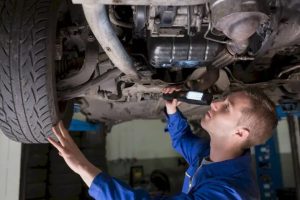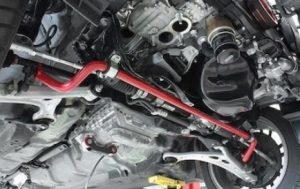When it comes to vehicle stability and control, few suspension components are as vital as sway bars (also known as anti-roll bars or stabilizer bars). These steel bars connect opposite wheels through short links, helping to reduce body roll during cornering and improving handling. But while sway bars are built to last, harsh climates — with their mix of moisture, temperature extremes, and road contaminants — can gradually wear them down.
Whether you drive in freezing winters, humid coastal areas, or scorching summer conditions, seasonal maintenance can significantly extend the lifespan of your sway bars and ensure consistent performance. Below, we’ll explore how climate affects stabilizer components, what to check each season, and how to protect your suspension from damage.
Why Seasonal Sway Bar Maintenance Matters

Sway bars and their components — including bushings, links, and brackets — are exposed to the same harsh elements as your tires and brakes. Over time, road salt, humidity, and thermal expansion cause corrosion, loosen fittings, and wear out rubber parts.
Without proper maintenance, this leads to:
-
Reduced handling precision
-
Clunking noises over bumps
-
Premature wear on suspension parts
-
Compromised safety during sharp turns
In climates with major temperature swings, these problems can worsen quickly. That’s why a proactive maintenance approach is essential.
Common Sway Bar Components and Their Vulnerabilities
| Component | Function | Typical Seasonal Issue | Maintenance Tip |
|---|---|---|---|
| Sway Bar (Main Bar) | Resists body roll during cornering | Corrosion from salt and moisture | Clean and coat with anti-rust spray |
| End Links | Connect sway bar to suspension | Loosen or seize due to rust | Lubricate and torque properly |
| Bushings | Cushion bar movement | Harden, crack, or squeak in cold | Replace with polyurethane or rubber-resistant type |
| Mounting Brackets | Hold sway bar in place | Rust or lose alignment | Inspect and clean every season |
Winter Maintenance: Combatting Cold and Corrosion
Winter is the most punishing season for sway bars, especially in regions that use road salt and de-icing chemicals. Cold temperatures can stiffen rubber bushings, while salt accelerates corrosion on metal components.
Winter Sway Bar Care Tips:
-
Thorough Cleaning Before Winter:
Wash the undercarriage, especially around the sway bar, links, and bushings, to remove dirt and grime that can trap moisture. -
Rust Prevention:
Apply a corrosion-resistant coating (such as a silicone-based spray or undercarriage protectant) to the bar and brackets. -
Inspect Bushings:
Look for cracks or stiffness — cold weather makes rubber brittle. Replace with all-weather or polyurethane bushings if needed. -
Check for Noise:
Clunking or squeaking when driving over bumps may indicate worn end links or dry bushings. Address these before they worsen.
Winter Maintenance Checklist
| Task | Purpose | Frequency |
|---|---|---|
| Clean sway bar and undercarriage | Remove salt buildup | Monthly |
| Lubricate end links and bushings | Maintain flexibility | Every 2 months |
| Inspect fasteners | Prevent loosening from vibration | Once mid-season |
| Apply anti-rust coating | Protect metal parts | Before winter |
Summer Maintenance: Managing Heat and Dust
Summer brings a different challenge — heat and dust. High temperatures cause rubber to soften and degrade, while dust and sand act as abrasives that accelerate wear on joints and bushings.
Summer Sway Bar Care Tips:
-
Inspect for Rubber Degradation:
Look for softened or swollen bushings — signs of heat and oil damage. -
Clean Dust and Debris:
Use compressed air or a water jet to clear dirt from around the sway bar and mounting areas. -
Check Torque on Bolts:
Heat expansion and rough roads can loosen fasteners over time. -
Reapply Protective Coating:
After cleaning, reapply a thin anti-corrosion or silicone layer to protect metal surfaces from oxidation.
Summer Maintenance Checklist
| Task | Purpose | Frequency |
|---|---|---|
| Wash undercarriage | Remove dust and grime | Bi-weekly |
| Inspect bushings | Prevent premature wear | Monthly |
| Tighten mounting bolts | Maintain stability | Every 5,000 km |
| Lubricate end links | Reduce friction and squeaks | Monthly |
Spring and Autumn Transition Checks
The periods between extreme seasons are the best times for a complete suspension inspection. During these transitions:
-
Check for Rust Accumulation: Remove rust spots and re-coat exposed metal.
-
Test Handling Response: If the car leans more in corners or feels unstable, sway bar components may be loose or worn.
-
Replace Worn Parts: Don’t postpone replacement — damaged bushings or links can compromise your entire suspension.
You can easily find high-quality replacements when you Buy Stabilizer & Components online.
Signs Your Sway Bar Needs Attention
If you notice these warning signs, it’s time for immediate inspection or replacement:
-
Clunking or rattling noises from the suspension area
-
Uneven handling during cornering
-
Squeaking sounds over bumps
-
Visible rust or broken end links
-
Excessive body roll when turning
Driving with a faulty sway bar not only reduces comfort but also affects safety — especially on wet or icy roads.
Choosing the Right Replacement Materials
When replacing sway bar components, opt for materials designed to handle your climate:
Recommended Materials:
-
Stainless steel or powder-coated bars – excellent corrosion resistance
-
Polyurethane bushings – more durable than rubber, ideal for extreme climates
-
Sealed end links – prevent dirt and moisture intrusion
Avoid:
-
Uncoated steel components — prone to rust
-
Low-grade rubber bushings — harden and crack in cold
Table: Material Comparison for Harsh Climates
| Component Type | Best Material | Climate Advantage |
|---|---|---|
| Sway Bar | Powder-coated or stainless steel | Resists corrosion and salt damage |
| Bushings | Polyurethane | Flexible under temperature swings |
| End Links | Zinc-plated steel or aluminum | Prevents seizing and rust |
| Brackets | Galvanized steel | Long-term rust protection |
All-Season Maintenance Tips

To keep your stabilizer system in top shape year-round:
-
Inspect sway bars every 20,000–30,000 km or twice a year.
-
Always clean the undercarriage after off-road or winter driving.
-
Replace bushings and links in pairs for balanced performance.
-
Check torque after major temperature changes or rough trips.
Conclusion
Sway bars are unsung heroes of vehicle stability — quietly maintaining control during every turn, bump, and corner. But in harsh climates, neglecting them can lead to corrosion, noise, and reduced safety.
By following seasonal maintenance practices — cleaning, lubricating, inspecting, and protecting — you can extend the life of your sway bars and enjoy confident handling all year long.
When it’s time for replacements or upgrades, make sure to Buy Stabilizer & Components online to ensure your suspension system remains durable, reliable, and climate-ready.